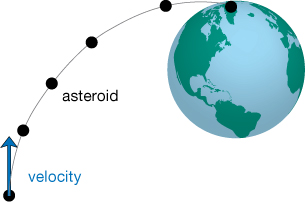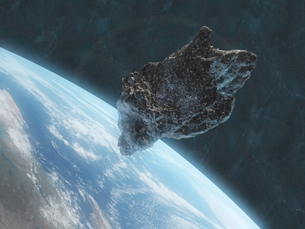Module 4—Gravitational Force

 Reflect and Connect
Reflect and Connect
Is it possible for an asteroid to pass near Earth and be “captured” by the gravitational field, causing it to follow the path illustrated here? Use the Weight and Orbits simulator to test this scenario. Consult the Show Me, if needed. You may be required to login with a username and a password. Contact your teacher for this information.
- After the simulator window opens, click the “Reset” button on the lower right of the window. Then set the scale to 100 px = 10 000 km (
 ).
).
- Reposition the asteroid—it is at the rear of the velocity vector arrow—by dragging it to where you want it.
- Adjust the velocity vector by dragging the tip to a new position or changing the numbers in the boxes and pressing “Enter.” Experiment with different velocities and distances, and view the weight, acceleration, and velocity vectors.
- Sketch the acceleration, velocity, and weight vectors on each of the yellow dots along the asteroid’s path in the image.
How does the gravitational field of Earth affect the magnitude and direction of the asteroid’s velocity? Place your answer to Reflect and Connect in your Physics 20 course folder.
 Discuss
Discuss
Using the information from the Reflect and Connect section, consider the mass and weight of the asteroid at each of the yellow points on the path. (View the weight vector on the simulator.)
D 1. Which quantity changes as it approaches Earth?
D 2. Why does this happen?
Post your answers to D 1 and D 2 to the discussion area. Consider at least two other responses and edit your own responses, if needed. Submit your final reflection to your instructor for feedback.
 Going Beyond
Going Beyond

© Sebastian Kaulitzki /shutterstock
NASA’s Near Earth Object (NEO) program defines an object as a comet or asteroid that has been nudged by the gravitational attraction of nearby planets, putting it into an orbit that may meet Earth at some point in the future.
As of 2007, NASA had identified 4559 NEOs that pose varying degrees of threat to the inhabitants of Earth, should these objects eventually crash into the planet. For example, the 400-m wide asteroid called 2004 MN4 is predicted to pass near Earth on April 13, 2029.
The odds of impact, based on observations up to 2007, are 1 in 300, which is deserving of special observation by astronomers. MN4 is the first object to receive a rating of 2 on the Torino scale. As NASA expands its searches, more objects will likely be found making a close but not unusual pass near Earth.
Research the purpose of the Near Earth Object program. Prepare a short report that discusses your findings. You should include responses to questions such as the following in your report:
- Is it possible to identify every threat?
- What is the Torino scale?
- How much time, money, and energy should be devoted to such a program?
- If we were informed of an upcoming, catastrophic collision, what would we do?
- Should the countries of the world be developing an impact prevention plan?
- What do you see this program consisting of?
- What are the cost and the benefits to the program?
 Reflect on the Big Picture
Reflect on the Big Picture
Each of the Reflect on the Big Picture sections in this module will ask you to consider travel to, exploration of, or study of space. To help you reflect on your learning from this lesson, complete at least one of these reflection activities.
- When Sputnik was launched on October 4, 1957, the world changed and the space race began. Explain.
- Create an illustration of the launch and orbit of Sputnik.
- Research space junk and satellites falling out of orbit.
- Create a multimedia presentation that includes photos (either your own or from the Internet) to illustrate how acceleration affects the orbits of satellites.
Store your completed reflection in your Physics 20 course folder.
 Module 4: Lesson 1 Assignment
Module 4: Lesson 1 Assignment
Remember to submit the Module 4: Lesson 1 Assignment to your teacher.
Your teacher may also require you to submit your Discuss questions and the report you wrote in the Going Beyond section either for marks or feedback.